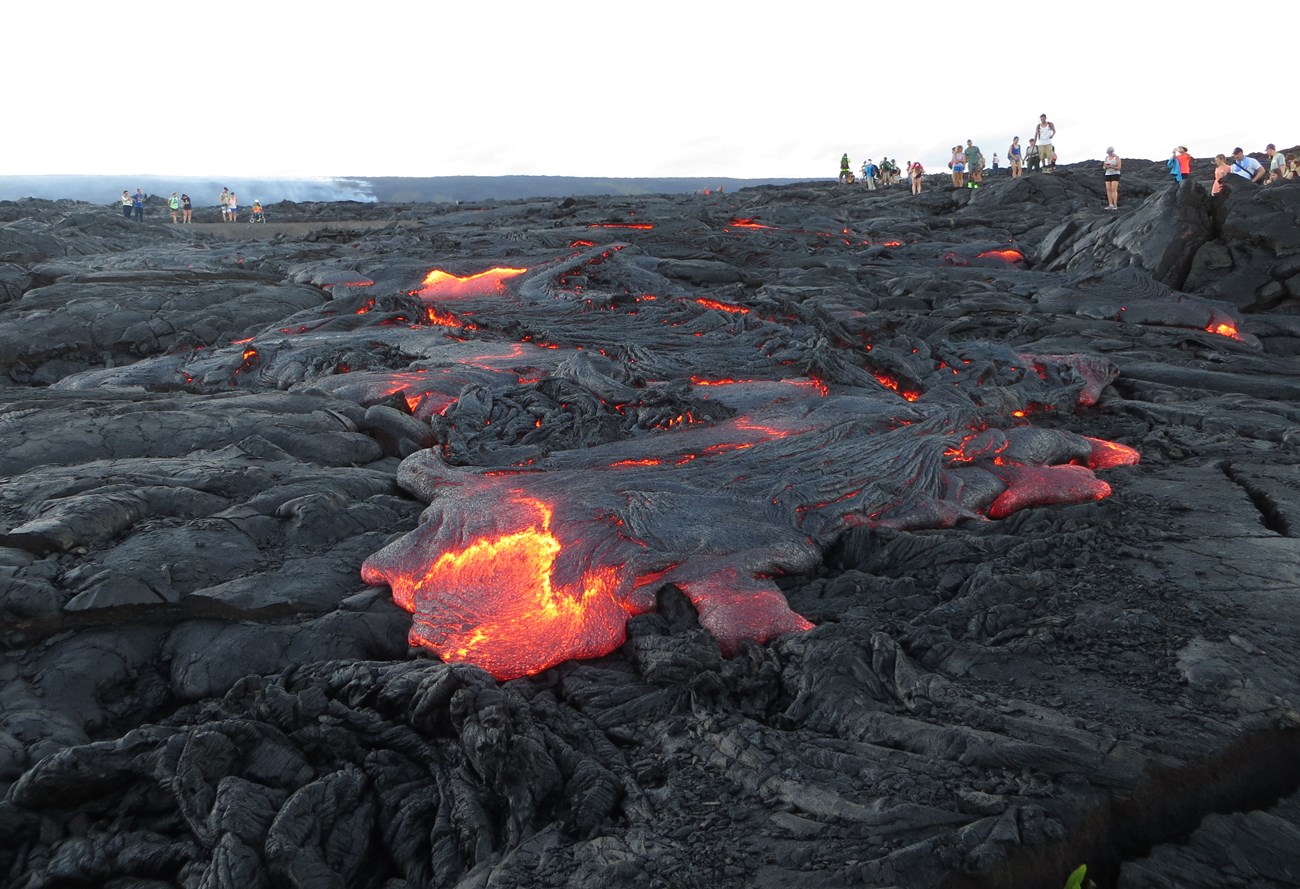
USGS Photo
Introduction
Red-hot lava oozing from a volcanic vent during an eruption and slowly, but unstoppably, spreading across the landscape is one of the most awe-inspiring natural phenomena on our active Earth. Visitors to Hawai’i Volcanoes National Park may be able to witness flowing lava first-hand depending on the current activity of Kīlauea and appropriate safety considerations.
Young lava flows (typically less than a few thousand years old depending on the climate in the region where they are present) create inhospitable landscapes (badlands or malpais) where the rough rumbly terrain may have little vegetation and consist of a hazardous irregular topography of rough rock surfaces with loose boulders, fissures, clefts, and mounds. Sunset Crater Volcano, Craters of the Moon, and El Malpais national monuments contain young lava flows with these characteristics.
Older lava flows are subject to the same agents of weathering and erosion as other rock types. Since they are resistant to erosion, older lava flows may hold up cliffs like in Petroglyph National Monument, although they may have lost many of the features, such as pāhoehoe ropes or brecciated flow-top surfaces. But these older flows may still contain other features such as vesicles, columnar jointing, and lava tubes that preserve details of their emplacement during eruptions. And even ancient lava flows such as in Isle Royale and Shenandoah national parks still retain some volcanic features.
Definition
Lava flow: An outpouring of molten rock from a vent onto Earth's surface during an effusive volcanic eruption; also, the resulting solidified body of rock.
Composition and Viscosity
Together, composition and viscosity are two of most important characteristics of molten rock that determine the length and other characteristics of lava flows.
Basaltic lavas have low silica (45-52 weight %), are hot (2200°F; 1200°C), and have low viscosity, meaning that they flow easily. Basaltic lava flows may travel many miles (kms) from their vents, and up to hundreds of miles (kms) in the case of extremely large lava flows known as flood basalts.
Lavas that contain more silica are more viscous than basaltic ones. Lava flows with intermediate compositions do not travel as far as basaltic ones, and generally have flow surfaces consisting of large blocks of lava ripped apart by shearing during flowage.
Silicic lavas are extremely viscous. Most silicic lava flows are short and stubby, and many effusive eruptions of silicic lavas form domes instead of lava flows. Silicic lava flows are also not as nearly as hot as basaltic ones (1300–1600°F; 700–900°C).
Basaltic Lava Flows
Basaltic lava flows are by far the most common type of lava flows on Earth. In fact, approximately 90% of all lava flows have basaltic compositions. Most, if not all, of the 60 national parks that contain lava flows include basaltic ones.
Basaltic lava flows are so predominant that most of the features and characteristics typically associated with lava flows are restricted to only basaltic ones. Pāhoehoe and ʻa‘ā, which are lava flow morphological forms, are only present in basaltic lava flows. Likewise, lava tubes only form in basaltic flows.
Basaltic lava flows are erupted from shield volcanoes, fissure volcanoes, in monogenetic volcanic fields, and from vents at the base of cinder cone volcanoes. They may also be erupted from some composite volcanoes.
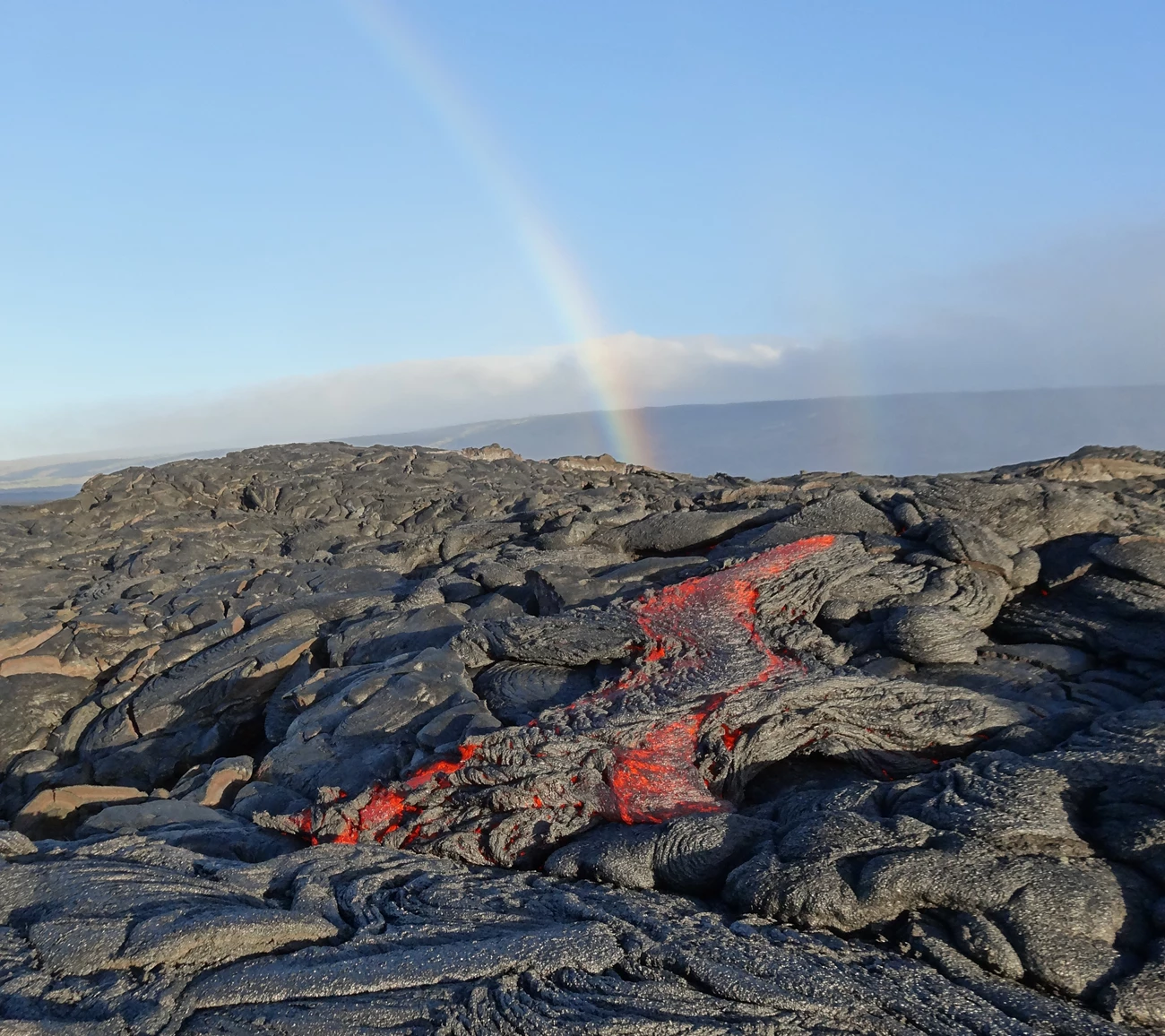
USGS photo.
Learn More
Block Lava Flows
Intermediate (52–66 weight % SiO2; mostly basaltic andesite and andesite) lavas usually make block lava flows, where the surface of the flows are composed of large angular blocks. These lava flows are thicker than basaltic ones and have very steep flow fronts.
Lavas with intermediate compositions may be erupted from composite volcanoes, and sometimes other types of volcanoes.
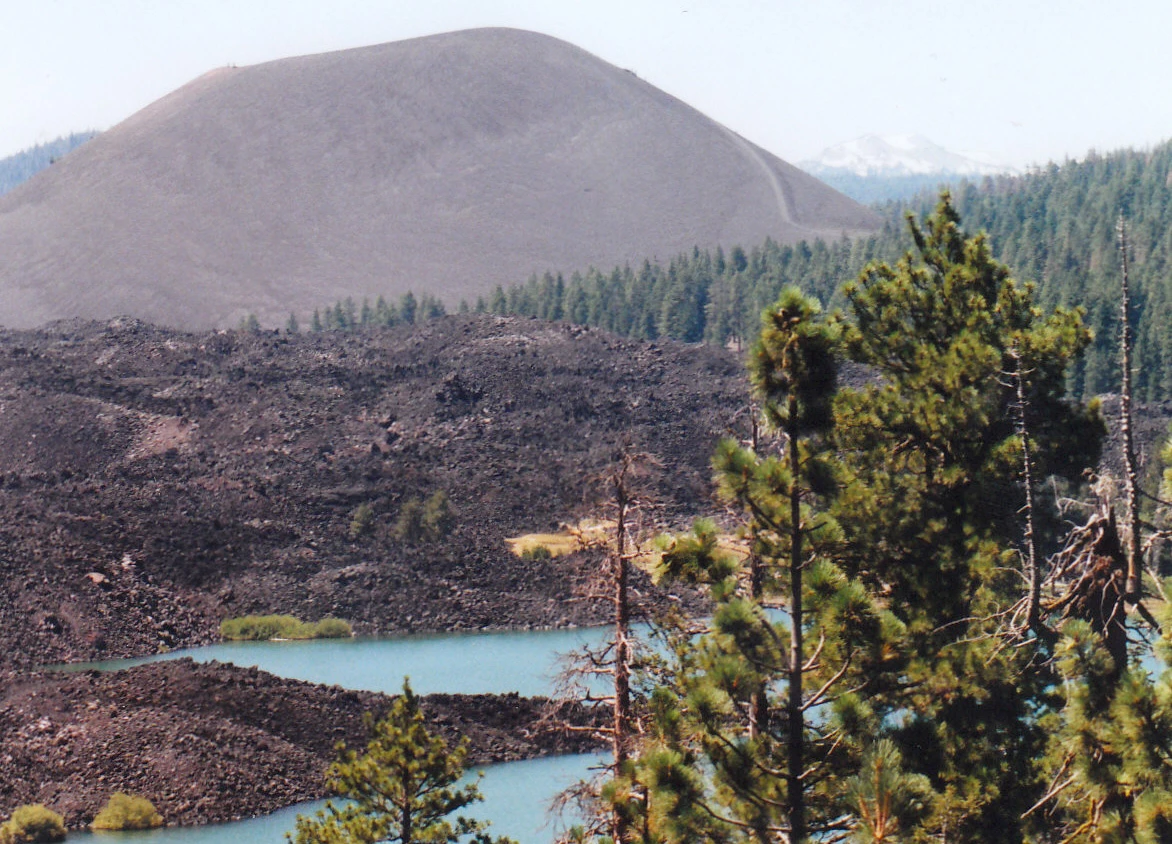
NPS photo.
Learn More
Silicic Lava Flows
Silicic (>66% weight % SiO2; dacite to rhyolite) lavas are relatively rare, but where they appear they tend to be very thick. Large volume lava flows are found in Yellowstone National Park.

NPS photo by Jim Peaco.
Volcanic Domes
Because of their extremely high viscosity, many silicic lavas form volcanic domes in which erupted lava mounds up above a vent instead of spreading out in a flow. Lava domes commonly form in summit craters of composite volcanoes, and may also form volcanic edifices of their own.
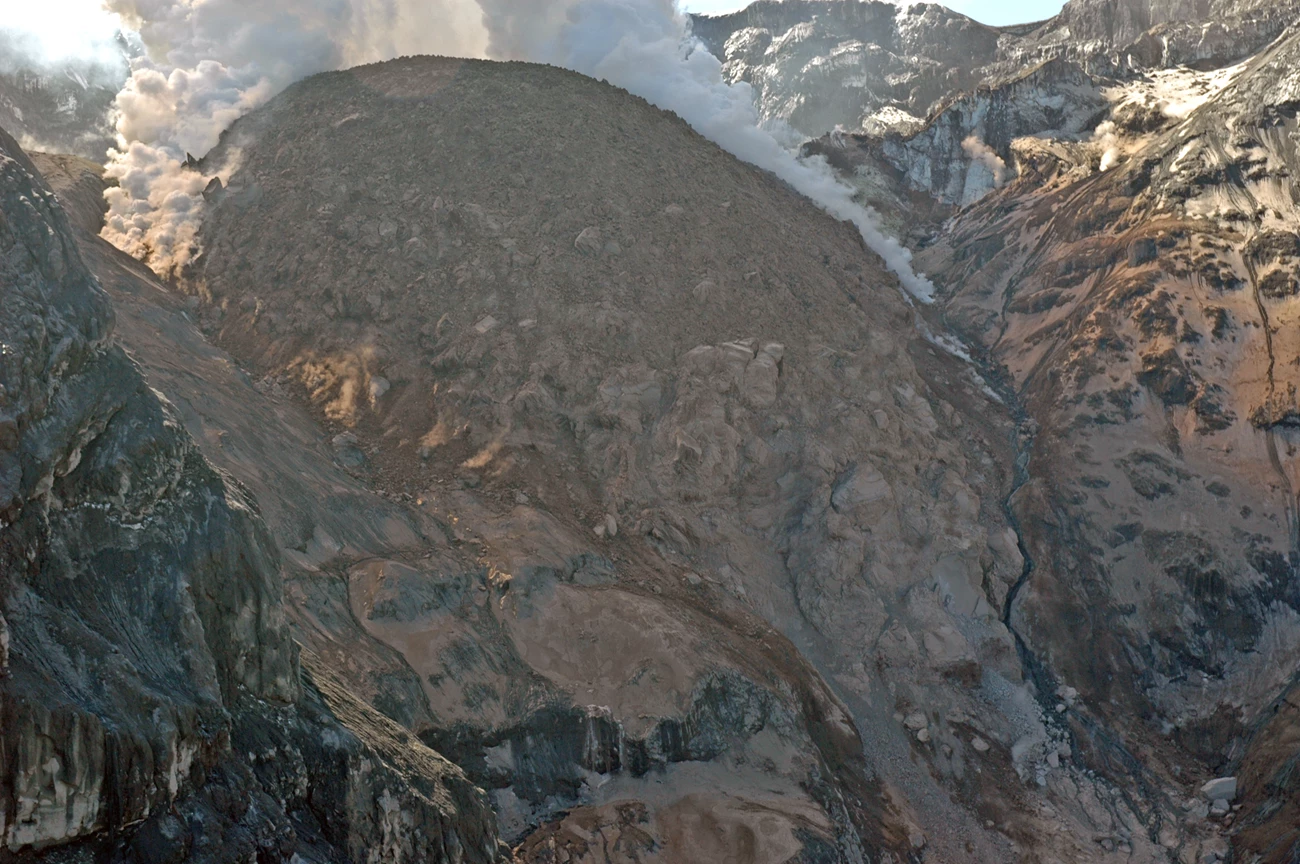
USGS AVO photo by R. G. McGimsey.
Learn More
Columnar Jointing
Columnar jointing (e.g., regular sets of fractures) form during cooling of lava flows. The joints form while the flows are still hot, but have solidified. It is found in lava flows of all compositions.

NOAA photo.
Learn More
Lava Flows in National Parks
Lava flows are the most common volcanic resource found in national parks. Lava flows are present in at least 60 of the 89 volcanic parks (units of the National Park System containing volcanoes or volcanic deposits). Just over half of these parks contain the volcano or volcanic center where the lava flows were erupted. The rest of these parks either contain lava flows erupted from vents outside of the park area or older lava flows.
Some units like Isle Royale and Voyageurs national parks contain ancient lava flows that are more than a billion years old, and others contain lava flows that were erupted in historic times. Depending on the eruption status of Kīlauea and Mauna Loa in Hawai’i Volcanoes National Park, they may be emitting lava flows at any given time. Aniakchak National Monument and Lassen Volcanic, Lake Clark, and Katmai national parks contain lava flows that were erupted in historic times.
Lava flows found in national parks include some of the most voluminous flows in Earth’s history. The Keweenaw Basalts in Keweenaw National Historic Park are flood basalts that were erupted 1.1 billion years ago. Nez Perce National Historic Park, John Day Fossil Beds National Monument, Lake Roosevelt National Recreation Area and other units on the Columbia Plateau contain exposures of the Columbia River Basalts, flood basalts that were erupted mostly between 16.7 and 15.5 million years ago.
Aniakchak National Monument
Numerous eruptions of lava flows occurred before and after Aniakchak’s caldera-forming eruption 3,660 ± 70 years ago. The most recent eruption occurred in 1931 and produced a small lava flow as well as tephra and ash fall.
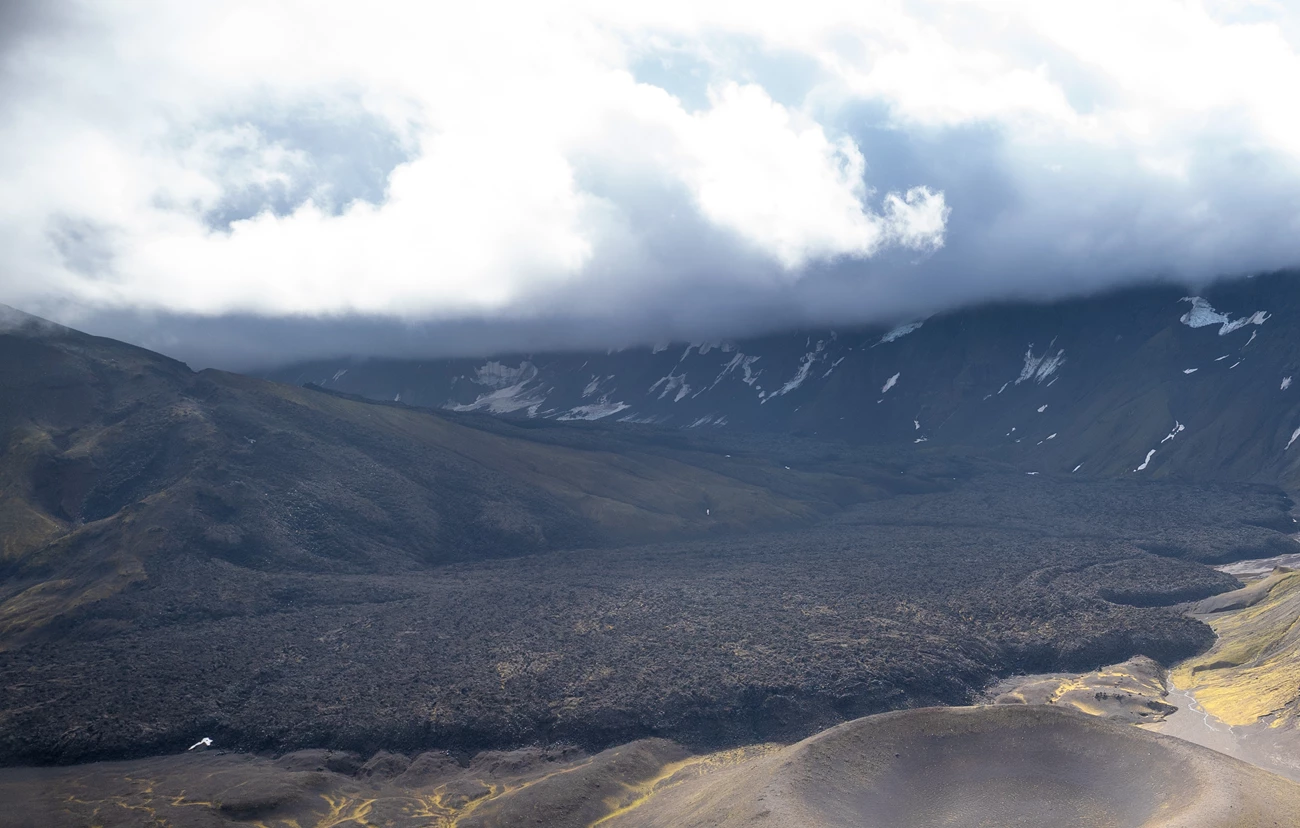
USGS AVO photo by Wyatt Mayo.
Related Link
Bering Land Bridge National Preserve
Bering Land Bridge National Preserve contains two volcanic fields that contain young basaltic lava flows.
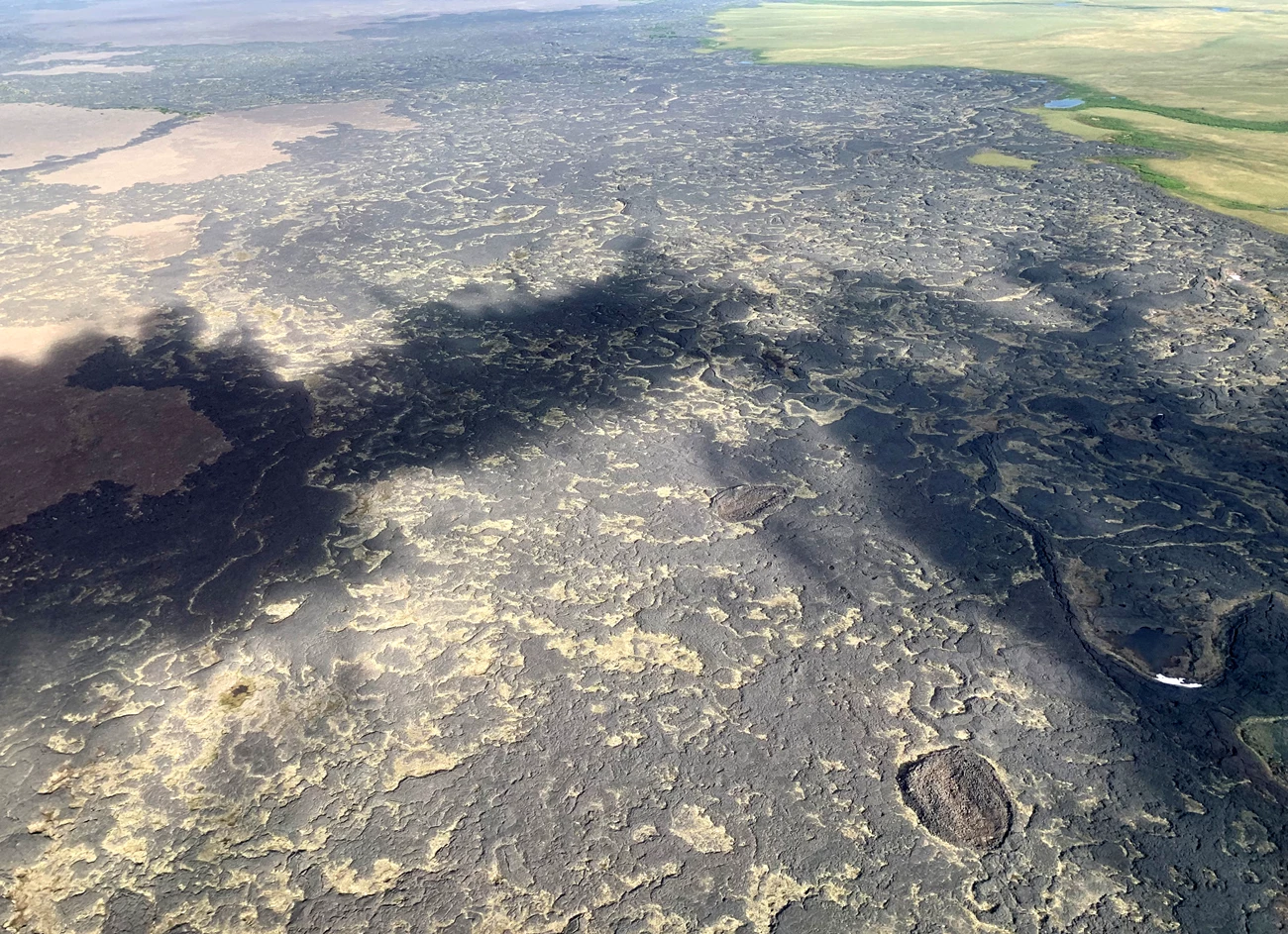
USGS AVO photo by Jessica Larsen, University of Alaska Fairbanks, Geophysical Institute.
Related Links
Craters of the Moon National Monument
Craters of the Moon consists of three lava fields of mostly basaltic pāhoehoe lava flows, although some block and ʻa‘ā morphologies are present. Volcanic activity in the park occurred between about 15,000 and 2,100 years ago.
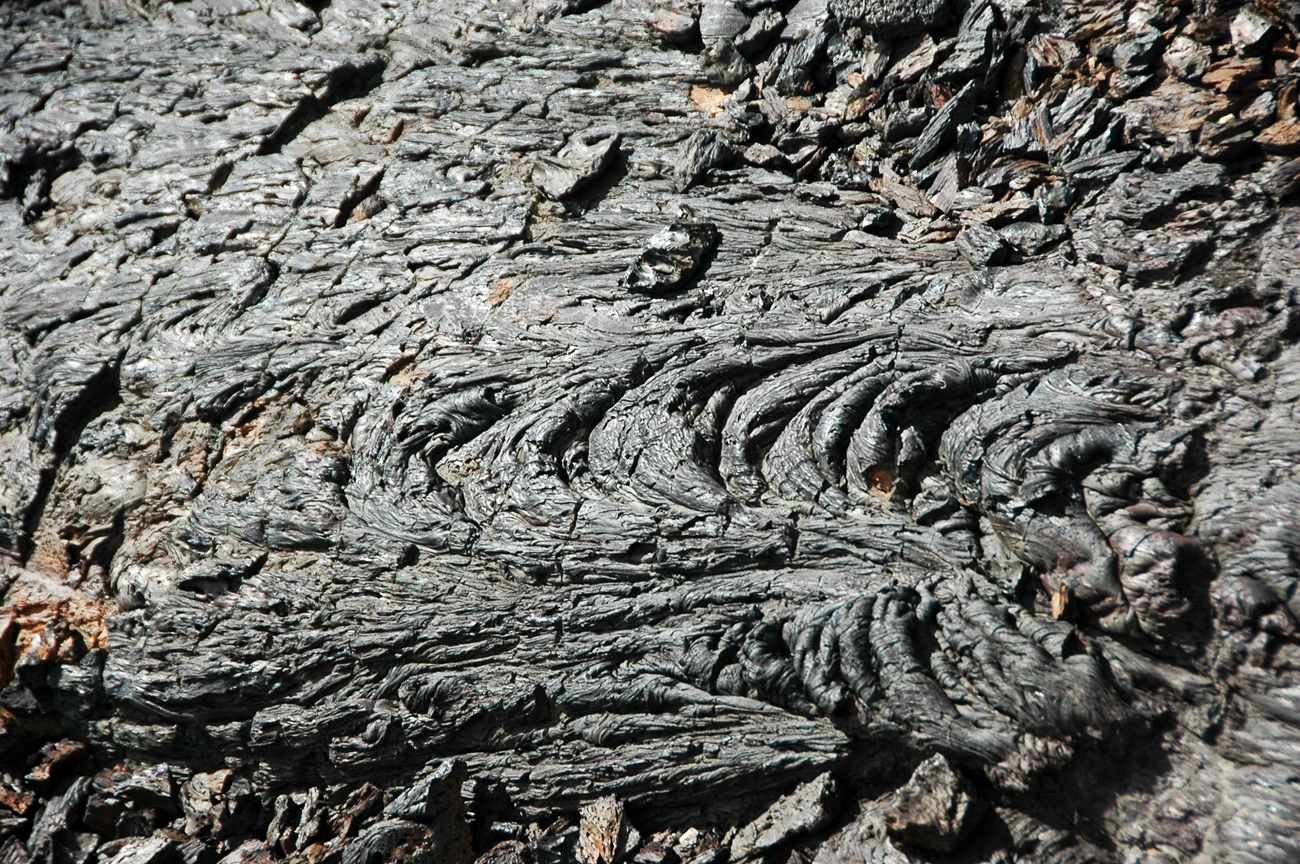
Photo by John St. James on Flickr.
Related Links
El Malpais National Monument
El Malpais National Monument is located within the Zuni-Bandera Volcanic Field, and contains five young basaltic lava flows that are notable for their length and diversity of surface features. The youngest of these is the McCartys Flow, erupted 3,900 years ago. It is the youngest in the state of New Mexico and has the site of important research that has produced significant insights into the emplacement mechanisms of basaltic lava flows.
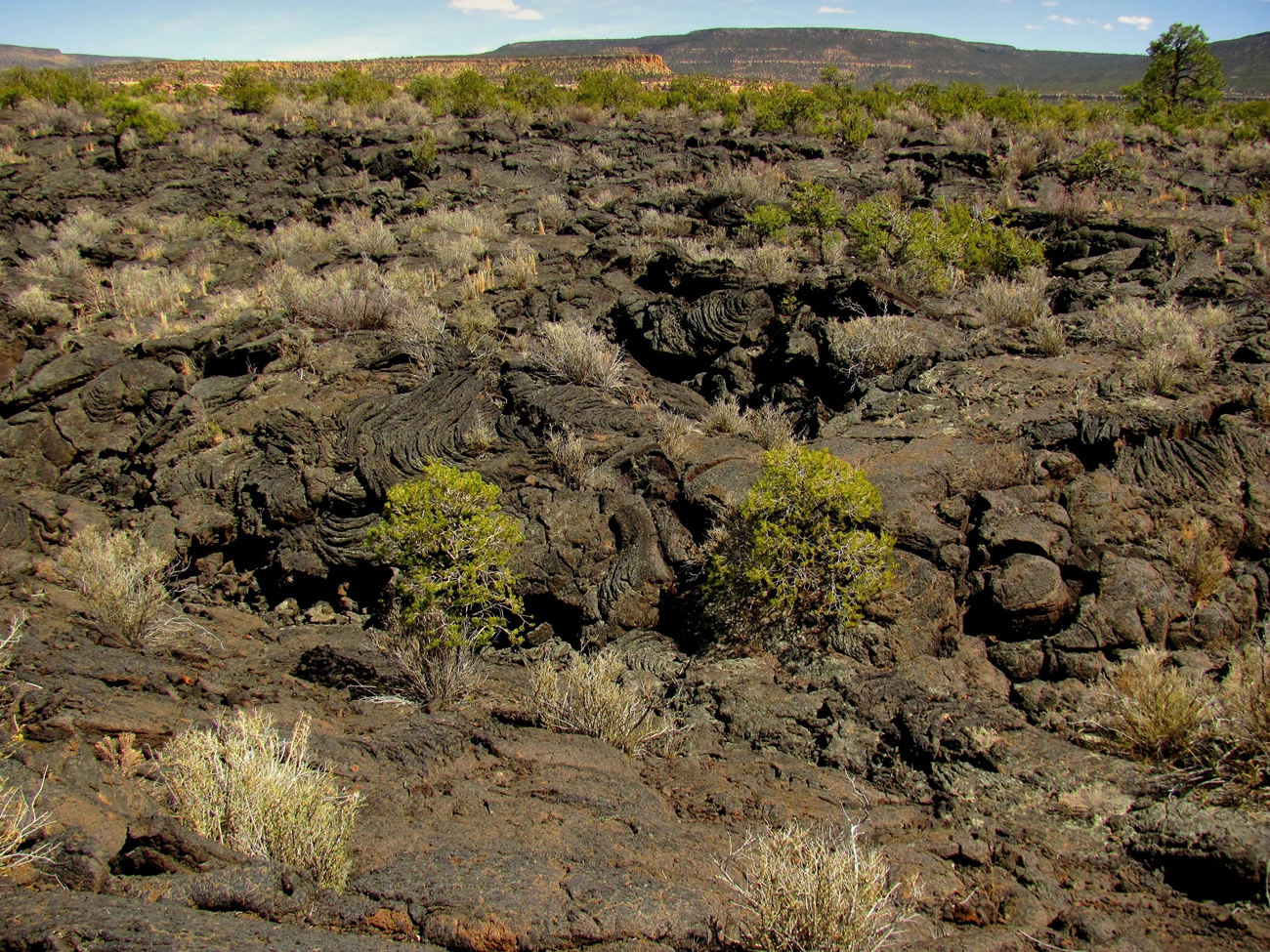
NPS photo by John Kuehnert.
Related Links
-
New Mexico Bureau of Geology and Mineral Resources—Basalts of the Zuni-Bandera Malpais
-
New Mexico Museum of Natural History and Science—Zuni-Bandera Field and McCartys Lava Flow Field
Grand Canyon National Park and Grand Canyon-Parashant National Monument
Some of the lava erupted in the Uinkaret Volcanic Field between 75,000 and 725,000 years ago flowed down canyon walls to reach the Colorado River. The dams that blocked the Colorado River were short short lived dams, but today these lava cascades are some of the most dramatic scenery in the western Grand Canyon.
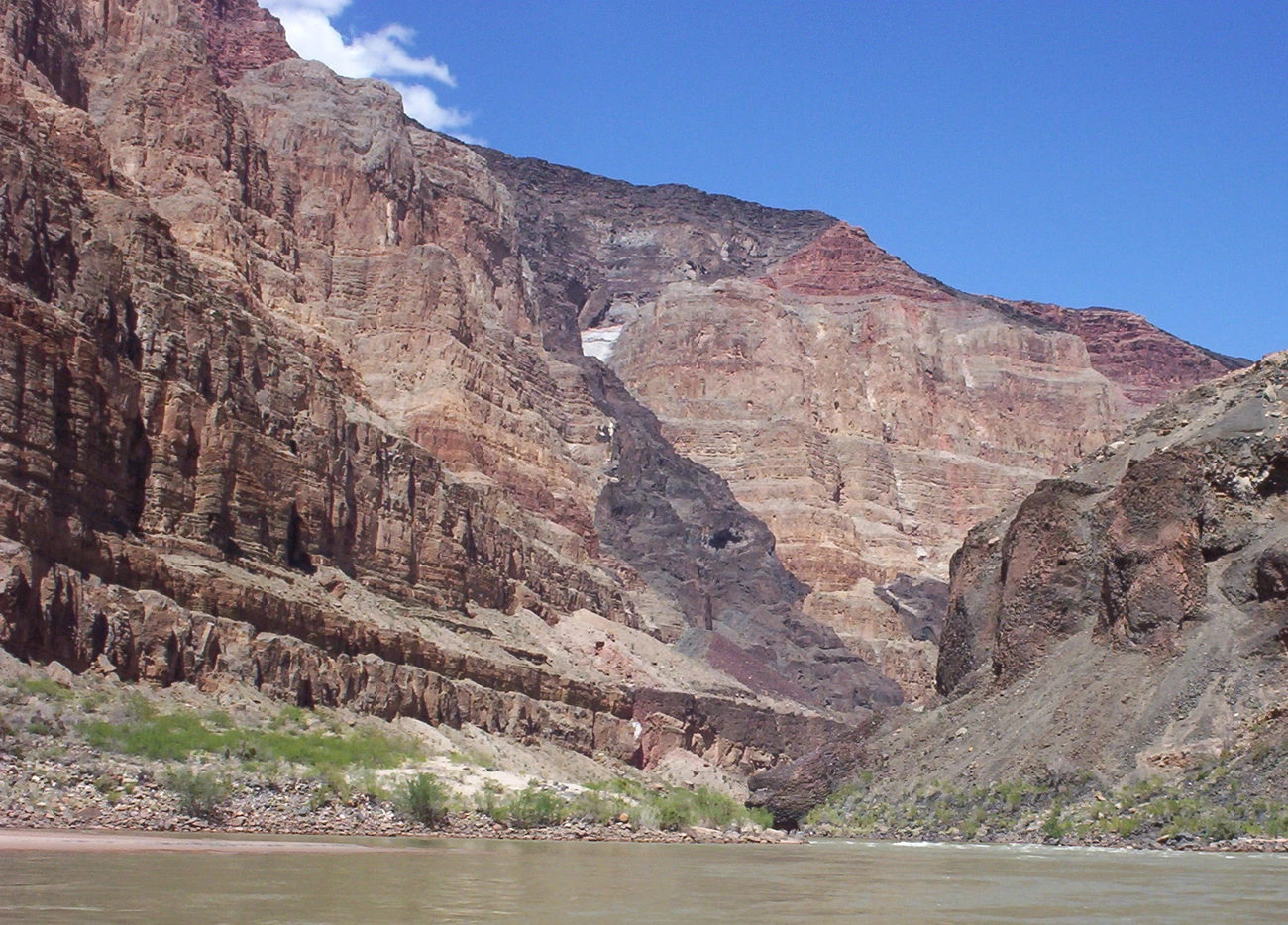
Photo by Allyson Mathis.
Related Link
Hawai’i Volcanoes National Park
Kīlauea and Mauna Loa are two of the most active volcanoes on Earth. As shield volcanoes, they are predominately made of lava flows. Kīlauea has had many historic periods of activity, including from 1983 to 2018, and a more recent eruption beginning in 2021. Mauna Loa’s most recent eruption was in 1984.
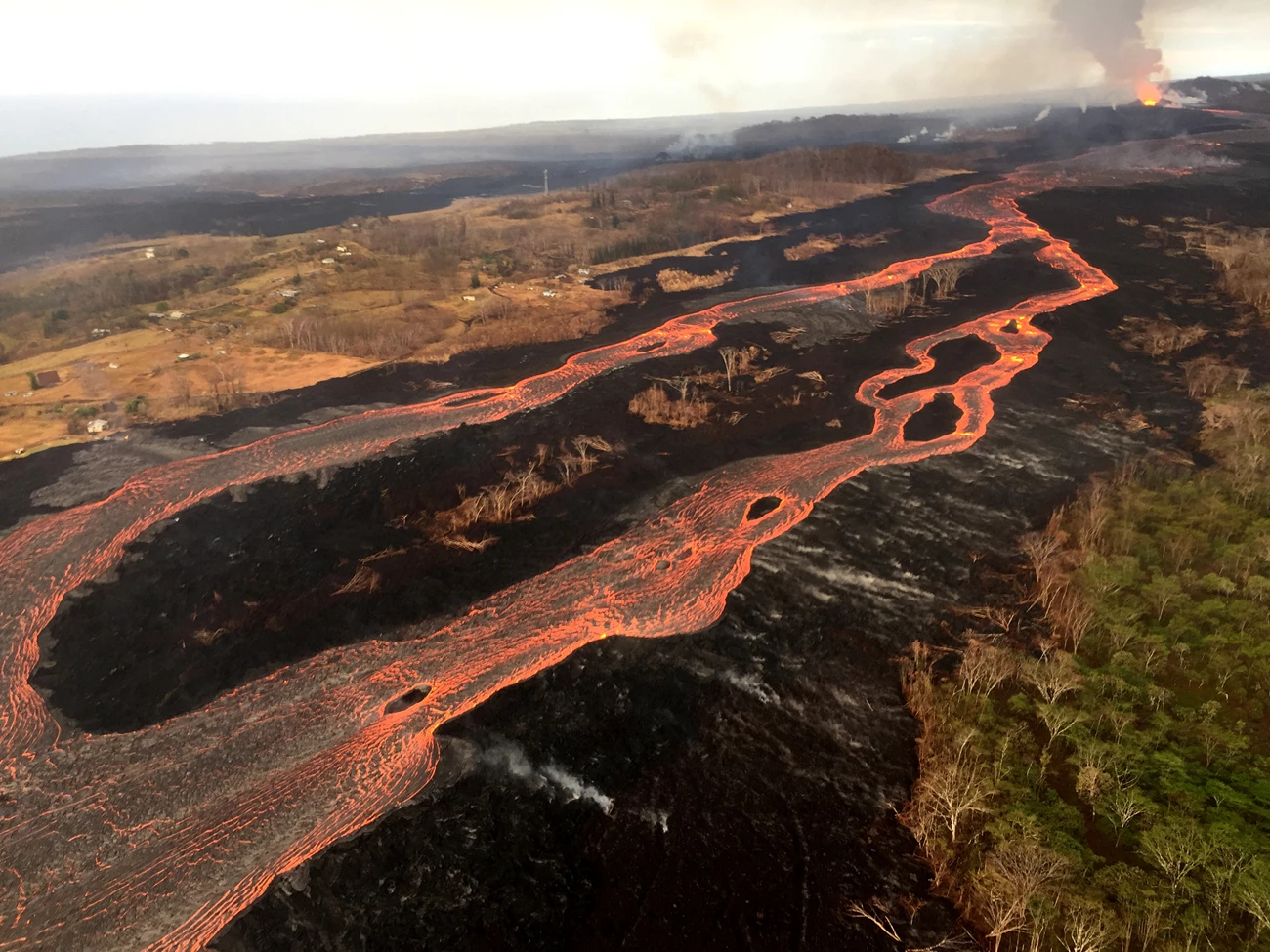
USGS photo.
Related Links
Isle Royale National Park
Isle Royale NP (and other parks in the Upper Midwest including Keweenaw National Historical Park, Voyageurs National Park, and Saint Croix National Scenic Riverway) contain voluminous basaltic lava flows that were erupted in the Midcontinent Rift approximately 1.1 billion years ago during pulling apart of the supercontinent Rodinia. More than 200 individual flows have been identified on the Keweenaw Peninsula where native copper was mined, predominately from mineralization in the flow tops. One of these lava flows, the Greenstone Flow is one of the largest lava flows recognized on Earth and has an aerial extent of more than 1,930 square miles (5,000 square km).

NPS photo.
Related Links
Katmai National Park
Katmai NP in southeastern Alaska is located on the Aleutian Peninsula, which is the most volcanologically active area in North America. Fourteen volcanoes in the park have experienced historic or prehistoric activity. Many of these volcanoes are composite cones which are composed of lava flows, and pyroclastic and lahar deposits.
Trident Volcano erupted from 1953-1974 and emitted a series of block lava flows. These andesitic flows are each about 1.5-2.5 mi (2.5-4 km) long and 80-200 ft (25-60 m) thick.
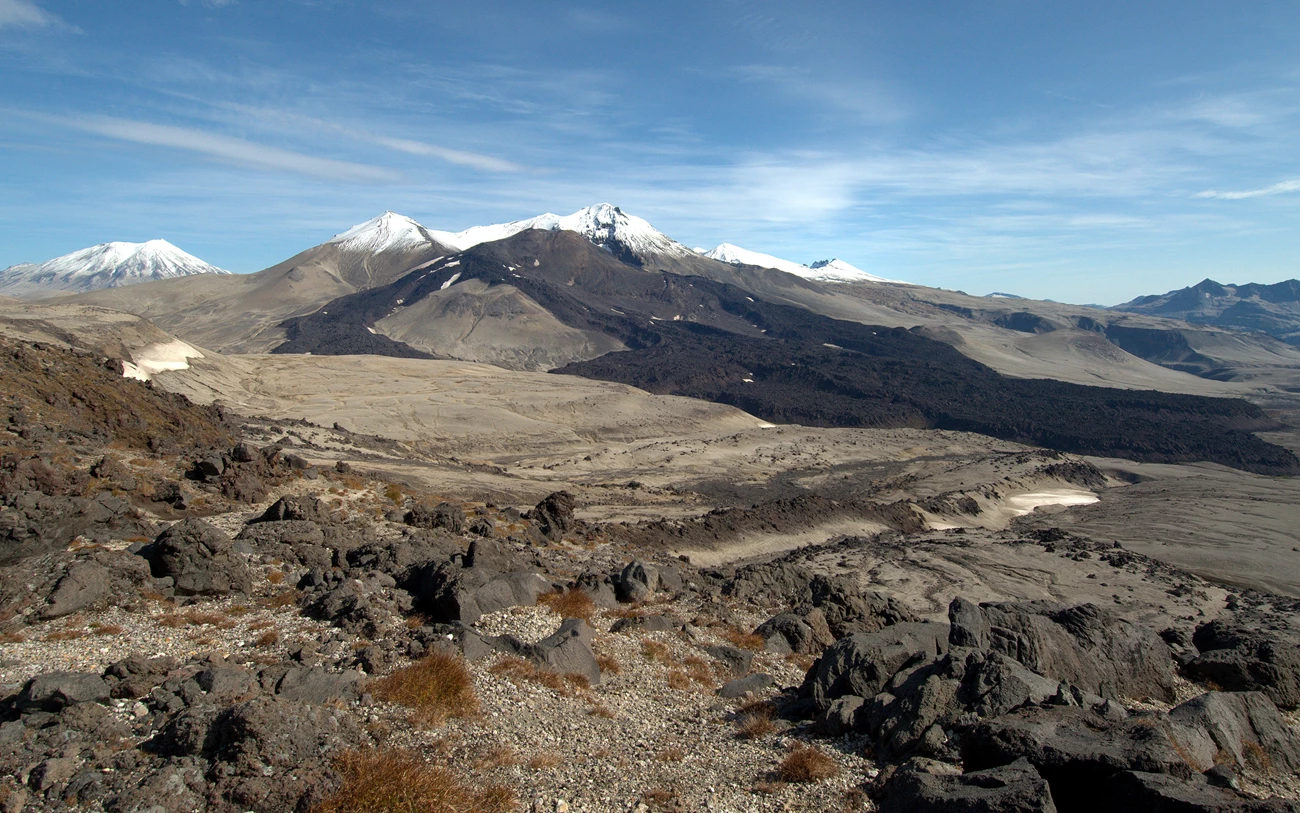
National Park & Preserve, Alaska.
USGS AVO photo by Cyrus Read.
Related Links
Lassen Volcanic National Park
Lassen Volcanic National Park has experienced a great variety of volcanic activity in the last few million years, with numerous lava flows and lava domes erupted.
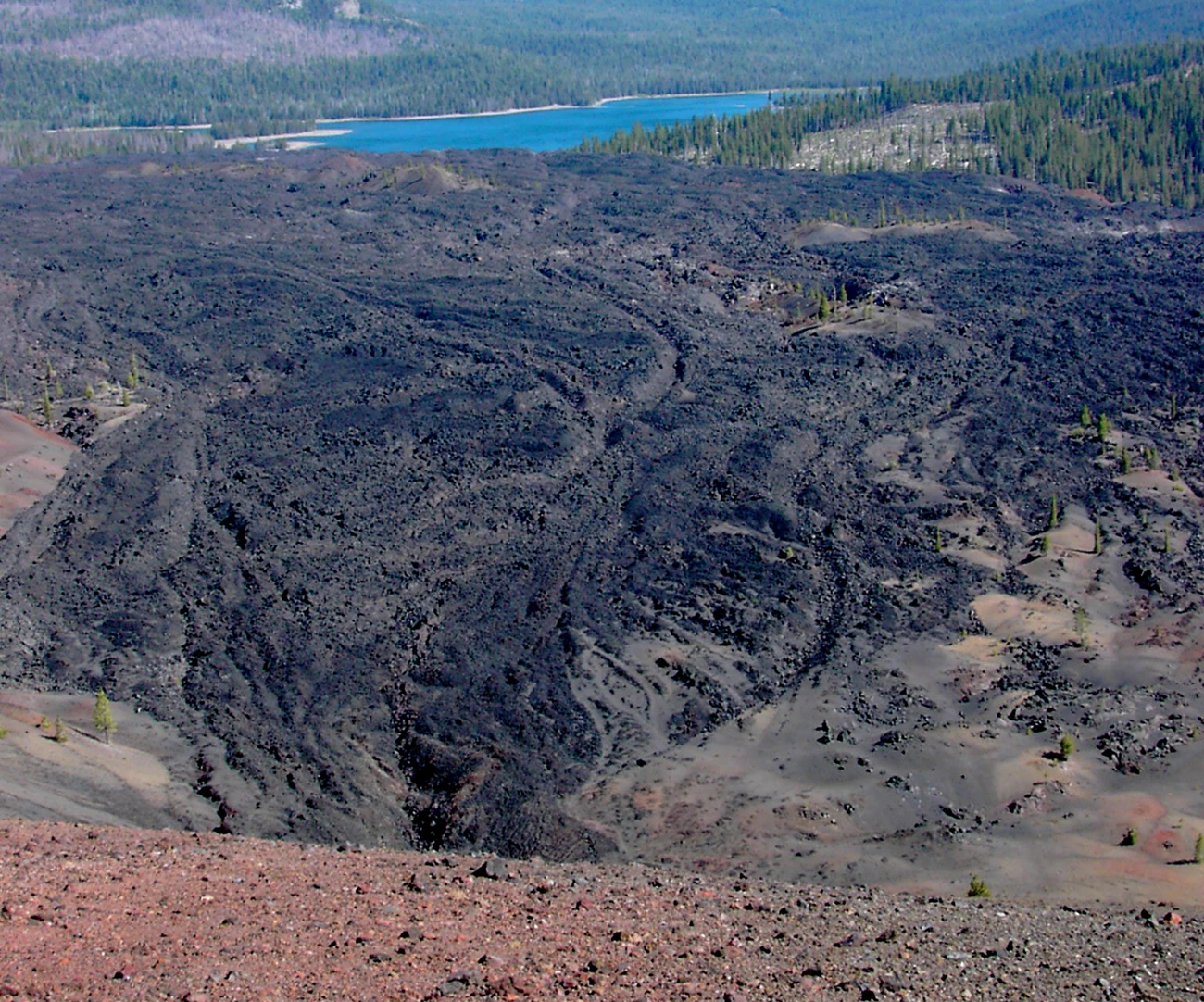
NPS photo.
Related Links
Mount Rainier National Park
Mount Rainier is a large composite volcano made primarily of andesitic lava flows as well as lahar deposits.
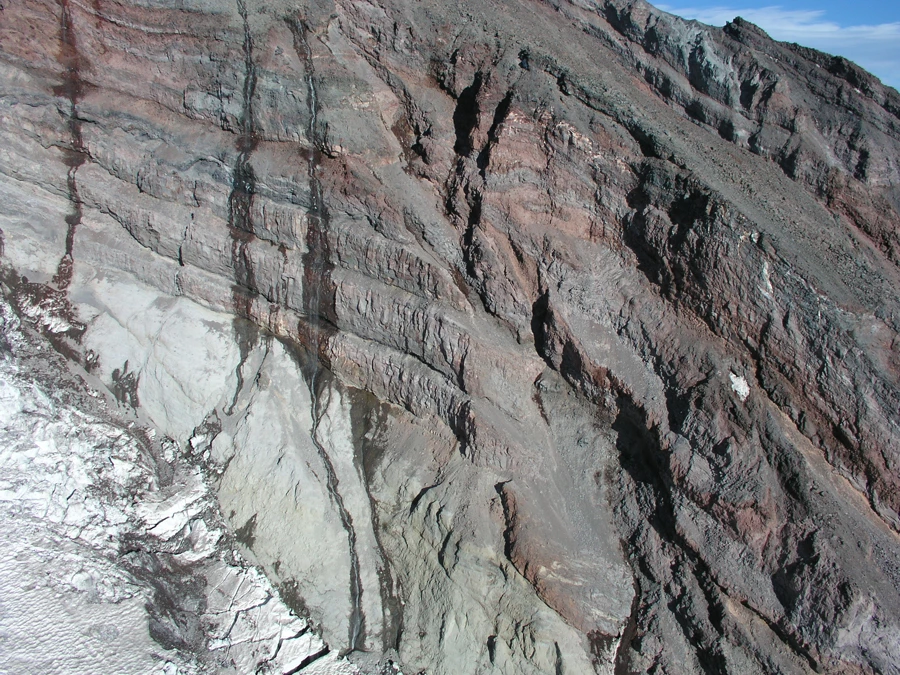
USGS photo by Tom Sisson.
Related Links
Sunset Crater Volcano National Monument
The Bonita lava flow was erupted near the end of the Sunset Crater Volcano eruption in 1085 CE. It shows both pāhoehoe and ʻa‘ā forms, but is primarily ʻa‘ā.
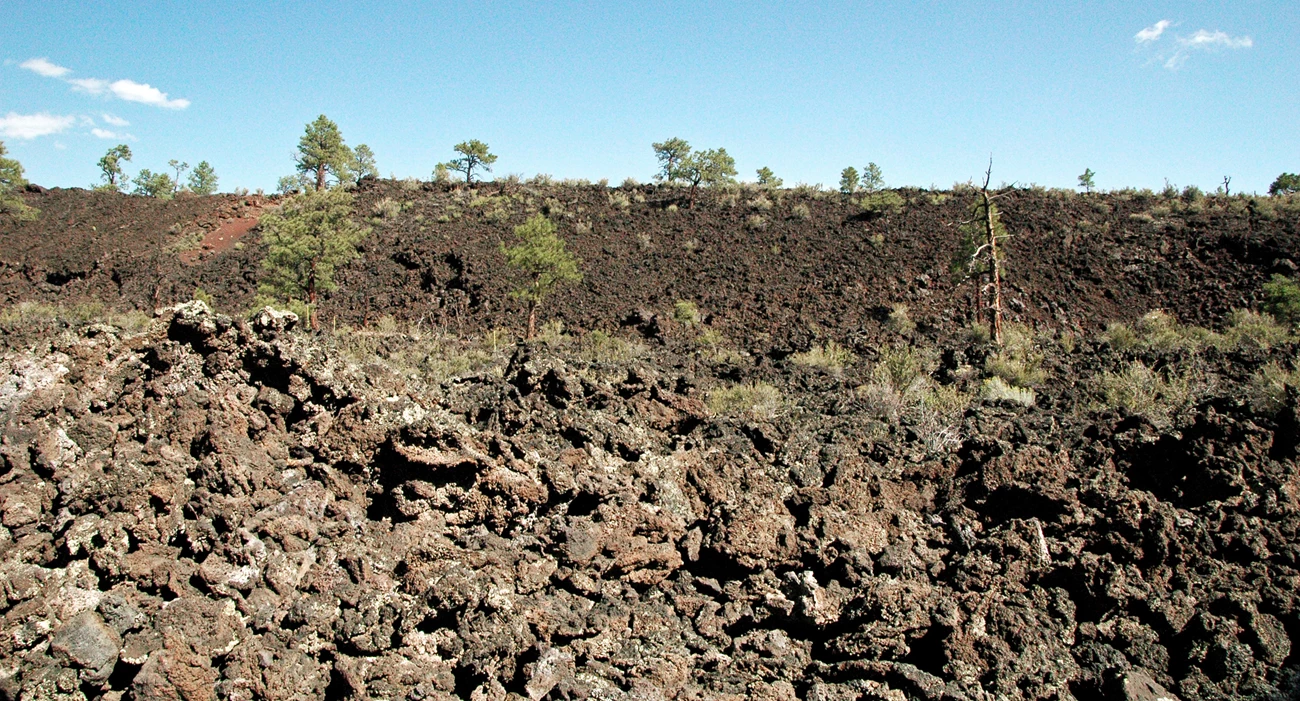
Photo by John St. James on Flickr.
Related Links
Yellowstone National Park
Volcanic activity has occurred in the Yellowstone region during the last 50 million years. The largest eruptions were the three caldera-forming ones between 2,100,000 and 640,000 years ago. Large-volume rhyolite lava flows were erupted in Yellowstone following the most recent caldera-forming super-eruption, mostly between 160,000 and 70,000 years ago.

Photo by J. Schmidt.
National Parks Containing Lava Flows
-
Aniakchak National Monument (ANIA), Alaska—[ANIA Geodiversity Atlas] [ANIA Park Home] [ANIA npshistory.com]
-
Bandelier National Monument (BAND), New Mexico—[BAND Geodiversity Atlas] [BAND Park Home] [BAND npshistory.com]
-
Bering Land Bridge National Preserve (BELA), Alaska—[BELA Geodiversity Atlas] [BELA Park Home] [BELA npshistory.com]
-
Big Bend National Park (BIBE), Texas—[BIBE Geodiversity Atlas] [BIBE Park Home] [BIBE npshistory.com]
-
Capulin Volcano National Monument (CAVO), New Mexico—[CAVO Geodiversity Atlas] [CAVO Park Home ] [CAVO npshistory.com]
-
Chiricahua National Monument (CHIR), Arizona—[CHIR Geodiversity Atlas] [CHIR Park Home] [CHIR npshistory.com]
-
Crater Lake National Park (CRLA), Oregon—[CRLA Geodiversity Atlas] [CRLA Park Home] [CRLA npshistory.com]
-
Craters of the Moon National Monument (CRMO), Idaho—[CRMO Geodiversity Atlas] [CRMO Park Home] [CRMO npshistory.com]
-
Death Valley National Park (DEVA), California & Nevada—[DEVA Geodiversity Atlas] [DEVA Park Home] [DEVA npshistory.com]
-
Devils Postpile National Monument (DEPO), California—[DEPO Geodiversity Atlas] [DEPO Park Home] [DEPO npshistory.com]
-
El Malpais National Monument (ELMA), New Mexico—[ELMA Geodiversity Atlas] [ELMA Park Home] [ELMA npshistory.com]
-
Fort Vancouver National Historic Site (FOVA), Washington—[FOVA Geodiversity Atlas] [FOVA Park Home] [FOVA npshistory.com]
-
Grand Canyon National Park (GRCA), Arizona—[GRCA Geodiversity Atlas] [GRCA Park Home] [GRCA npshistory.com]
-
Grand Canyon-Parashant National Monument (PARA), Arizona—[PARA Geodiversity Atlas] [PARA Park Home] [PARA npshistory.com]
-
Grand Teton National Park (GRTE), Wyoming—[GRTE Geodiversity Atlas] [GRTE Park Home] [GRTE npshistory.com]
-
Great Basin National Park (GRBA), Nevada—[GRBA Geodiversity Atlas] [GRBA Park Home] [GRBA npshistory.com]
-
Hagerman Fossil Beds National Monument (HAFO), Idaho—[HAFO Geodiversity Atlas] [HAFO Park Home] [HAFO npshistory.com]
-
Haleakala National Park (HALE), Hawaii—[HALE Geodiversity Atlas] [HALE Park Home] [HALE npshistory.com]
-
Hawai’i Volcanoes National Park (HAVO), Hawai’i—[HAVO Geodiversity Atlas] [HAVO Park Home] [HAVO npshistory.com]
-
Isle Royale National Park (ISRO), Michigan—[ISRO Geodiversity Atlas] [ISRO Park Home] [ISRO npshistory.com]
-
John Day Fossil Beds National Monument (JODA), Oregon—[JODA Geodiversity Atlas] [JODA Park Home] [JODA npshistory.com]
-
Kalaupapa National Historical Park (KALA), Hawai’i—[KALA Geodiversity Atlas] [KALA Park Home] [KALA npshistory.com]
-
Kaloko-Honokohau National Historical Park (KAHO), Hawai'i—[KAHO Geodiversity Atlas] [KAHO Park Home] [KAHO npshistory.com]
-
Katmai National Park (KATM), Alaska—[KATM Geodiversity Atlas] [KATM Park Home] [KATM npshistory.com]
-
Kenai Fjords National Park (KEFJ), Alaska—[KEFJ Geodiversity Atlas] [KEFJ Park Home] [KEFJ npshistory.com]
-
Keweenaw National Historic Park (KEWE), Michigan—[KEWE Geodiversity Atlas] [KEWE Park Home] [KEWE npshistory.com]
-
Lake Clark National Park and Preserve (LACL), Alaska—[LACL Geodiversity Atlas] [LACL Park Home] [LACL npshistory.com]
-
Lake Mead National Recreation Area (LAKE), Arizona and Nevada—[LAKE Geodiversity Atlas] [LAKE Park Home] [LAKE npshistory.com]
-
Lake Roosevelt National Recreation Area (LARO), Washington—[LARO Geodiversity Atlas] [LARO Park Home] [LARO npshistory.com]
-
Lassen Volcanic National Park (LAVO), California—[KEWE Geodiversity Atlas] [KEWE Park Home] [KEWE npshistory.com]
-
Lava Beds National Monument (LABE), California—[LABE Geodiversity Atlas] [LABE Park Home] [LABE npshistory.com]
-
Lewis and Clark National Historical Park (LEWI), Oregon and Washington—[Volcanoes of the Lewis & Clark Trail]
-
Manhattan Project National Historical Park (MAPR), NM, WA, and TN—[MAPR Park Home] [MAPR npshistory.com]
-
Minidoka Internment National Monument (MIIN), Idaho—[Geodiversity Atlas] [MIIN Park Home] [MIIN npshistory.com]
-
Mojave National Preserve (MOJA), California—[MOJA Geodiversity Atlas] [MOJA Park Home] [MOJA npshistory.com]
-
Mount Rainier National Park (MORA), Washington—[MORA Geodiversity Atlas] [MORA Park Home] [MORA npshistory.com]
-
National Park of American Samoa (NPSA), American Samoa—[NPSA Geodiversity Atlas] [NPSA Park Home] [NPSA npshistory.com]
-
Nez Perce National Historical Park (NEPE), ID, OR, MT, and WA—[NEPE Geodiversity Atlas] [NEPE Park Home] [NEPE npshistory.com]
-
Olympic National Park (OLYM), Washington—[OLYM Geodiversity Atlas] [OLYM Park Home] [OLYM npshistory.com]
-
Organ Pipe Cactus National Monument (ORPI), Arizona—[ORPI Geodiversity Atlas] [ORPI Park Home] [ORPI npshistory.com]
-
Petrified Forest National Park (PEFO), Arizona—[PEFO Geodiversity Atlas] [PEFO Park Home] [PEFO npshistory.com]
-
Petroglyph National Monument (PETR), New Mexico—[PETR Geodiversity Atlas] [PETR Park Home] [PETR npshistory.com]
-
Pinnacles National Monument (PINN), California—[PINN Geodiversity Atlas] [PINN Park Home] [PINN npshistory.com]
-
Pu'uhonau o Honaunau National Historic Park (PUHO), Hawai'i—[PUHO Geodiversity Atlas] [PUHO Park Home] [PUHO npshistory.com]
-
Pu'ukohola Heiau National Historic Site (PUHE), Hawai'i—[PUHE Geodiversity Atlas] [PUHE Park Home] [PUHE npshistory.com]
-
Redwood National Park (REDW), California—[REDW Geodiversity Atlas] [REDW Park Home] [REDW npshistory.com]
-
Rocky Mountain National Park (ROMO), Colorado—[ROMO Geodiversity Atlas] [ROMO Park Home] [ROMO npshistory.com]
-
Saguaro National Park (SAGU), Arizona—[SAGU Geodiversity Atlas] [SAGU Park Home] [SAGU npshistory.com]
-
Saint Croix National Scenic Riverway (SACR), Wisconsin and Minnesota—[SACR Geodiversity Atlas] [SACR Park Home] [SACR npshistory.com]
-
Santa Monica Mountains National Recreation Area (SAMO), California—[SAMO Geodiversity Atlas] [SAMO Park Home] [SAMO npshistory.com]
-
Shenandoah National Park (SHEN), Virginia—[SHEN Geodiversity Atlas] [SHEN Park Home] [SHEN npshistory.com]
-
Sunset Crater Volcano National Monument (SUCR), Arizona—[SUCR Geodiversity Atlas] [SUCR Park Home] [SUCR npshistory.com]
-
Valles Caldera National Preserve (VALL), New Mexico—[VALL Geodiversity Atlas] [VALL Park Home] [VALL npshistory.com]
-
Voyageurs National Park (VOYA), Minnesota—[VOYA Geodiversity Atlas] [VOYA Park Home] [VOYA npshistory.com]
-
War in the Pacific National Historical Park (WAPA), Guam—[WAPA Geodiversity Atlas] [WAPA Park Home] [npshistory.com]
-
Wrangell-St. Elias National Park and Preserve (WRST), Alaska—[WRST Geodiversity Atlas] [WRST Park Home] [WRST npshistory.com]
-
Wupatki National Monument (WUPA), Arizona—[WUPA Geodiversity Atlas] [WUPA Park Home] [WUPA npshistory.com]
-
Yellowstone National Park, Wyoming (YELL), Idaho, and Montana—[YELL Geodiversity Atlas] [YELL Park Home] [YELL npshistory.com]
-
Yosemite National Park (YOSE), California—[YOSE Geodiversity Atlas] [YOSE Park Home] [YOSE npshistory.com]
-
Zion National Park (ZION), Utah—[ZION Geodiversity Atlas] [ZION Park Home] [ZION npshistory.com]
Last updated: April 18, 2023
